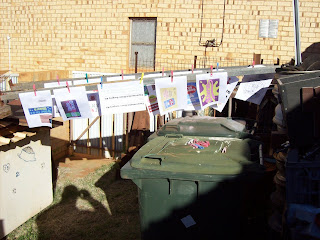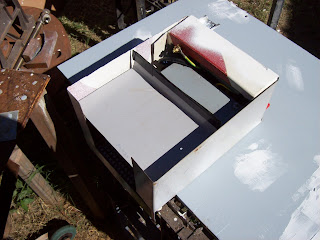Hardware fabrication
Hinges
Using the design I created, I needed to be able to remove the door to use as a work surface. I built two hinges from brass - 1/8"T x 2"W brass strip, and some brass rod salvaged from the spindle of an old household tap.
 |
| Figure 1 - Hinge materials |
The hinges were patterned on a half barrel hinge style similar to those used on trailers for the tail gate - I choose that design so the door could be removed in a similar fashion.
 |
| Figure 2 - Hinges under construction - engaged |
The spindle was cut and then turned in the lathe (Taig) to make the parts. Once made, the strip brass was cut and filed to suit the parts, and then all pieces soldered together.
 |
| Figure 3 - Hinges under construction - released |
Once the hinges were finished, I inlaid them into the floor and door of the desk, and rebated in the backing plates on the reverse side of these surfaces. The screws securing the hardware are all 3/16" UNC (10-24 for our US cousins) into a nut plate on the reverse side.
 |
| Figure 4 - Hinges fitted - engaged |
A notch has been cut in the RH side panel to permit the door to be removed similar to a trailer tailgate.
 |
| Figure 5 - hinges fitted - door released |
Locks
Next thing to make was the locks. The requirements on the locks was that the door had to be perfectly flat on both sides - the outside so it would lay on a table top and not scratch the table, the inner surface needs to be flat so it can form the working surface when I'm using the desk.
I planned on making disc-locks, but after reviewing my stock of materials, came to the conclusion that cam locks would be the design. I did not have much in the way of 1/2" diameter brass rod, so I decided to use a cartridge case (.243 Win) to form the shaft. (I have a stash of around 20 of these cartridge cases which were given to me for scrap brass). The cam plate was roughly made up, and then soldered to the cartridge case at the appropriate height to permit the base of the cartridge to be used as actuating surface outside the door.
 |
| Figure 6 - Cam lock under construction |
The front and back plates were made up, and the lock assembled. Only once assembled was the cam shaped to its final length, with some easing to improve its alignment when turned. The base of the cartridge was spot-drilled to match the "keys" I made - basically a small pin-wrench.
 |
| Figure 7 - Pin-wrench "key" under construction |
The pin wrench started life as one of those promotional key-chain bottle openers, but after cutting and drilling a pair of nails were driven in and cut and filed to make the pin-wrenches. I made 2 of the keys so I have a spare.
 |
| Figure 8 - Finished lock - in locked position |
Once the front and back plates were completed, a top plate was made and soldered to the front plate. Clearance slots for the cam operation was made, and suitably relieved for easy use. The holes in the lock were drilled to indicate the lock status - vertical holes indicate the lock is "locked", horizontal holes indicate unlocked - there is only 90 degrees of movement in the lock mechanism.
 |
| Figure 9 - Finished lock in unlocked position |
Door opening mechanism - The Pusher
Since the door has to be perfectly flat on both sides, there is no handle. I considered a flip out handle, I considered simply drilling a hole to poke my finger through - both ideas had aspects which did not appeal to my sense of this project... What I really needed was something inside the desk to push the door out once the locks were released... What I came up with was "the pusher".
The pusher is nothing more than a simple spring loaded detent plunger - but instead of pressing into a detent hole, it simply pushes the door away from the locked position by about 1/2" - more than enough to get my finger on to lower the door to the table top. The pusher uses another .243" cartridge casing for the spring holder, and the plunger is made from more tap spindle stock. Who knows where the spring came from, I've boxes of salvaged "useful junk" which gets pawed through when I do jobs like this.
 |
| Figure 10 - Pusher components |
The spring casing is rebated into the riser, and the cover plate relieved into the edge so there is no protrusion other than the plunger.
 |
| Figure 11 - Pusher spring casing installed |
This piece of hardware is the only one secured with normal wood screws into wood - all others use the nut-plate method described in the hinges. The screws into timber should be able to hold the minor force of the spring at the end of its travel.
 |
| Figure 12 - Pusher installation nearly complete |
Once the locks are unlocked, the pusher moves the door about 3/4" if the LHS doesn't grab (that bowed panel as mentioned when I built the carcass), 1/2" if it does rub... either way I can still open the door easily.
 |
| Figure 13 - Result of pusher on unlocked door |
Handle
The other piece of hardware to build was the handle. Most of my toolboxes have handles which protrude on the lid - making it nearly impossible to stack things on top. Given the intended use of this desk is in a "accommodation camp" where I may need to stack a laptop, or books on top, I was insistent that the handle design had to leave the top surface perfectly flat. The ideal scenario would have been to use the folding handle from the top of a 7.62 x 51mm ammo can - but I couldn't find any. I did not trust my skills to make one, so I looked at every box and case I owned looking for a low profile handle - I stole this idea off an industrial first-aid cabinet.
 |
| Figure 14 - Handle components |
The basic strap (handle) is made from 2 layers of pallet strapping - the 3/4" wide blue/black metal banding you find on pallets of bricks and other heavy things. I drilled and slotted it, then shrunk two layers of heat-shrink tuning over it to make the handle comfortable. I then made a pair of brass "sockets" which hold the handle, and allow it to slide in it slot for extending under weight, or retracting when not in use. I made the top plates for the sockets larger than required and drilled 2 large holes in each for attaching labels (addressing, or shipping labels).
 |
| Figure 15 - Assembled handle |
Since I'd already glued the carcass together (my enthusiasm bit me hard there) I had to make my own "T-Nuts" to engage from the underside. Basically cylindrical spigots soldered to shim brass which were then friction fitted into holes in the timber. I wasn't feeling overly confident in the solder joints, so I backed the nuts up with some Loctite CA glue. If the nuts pull through, I'll have to look at redesigning the handle nuts, but so far OK.
 |
| Figure 16 - Completed field desk with all hardware |
Since nothing was rebated in, and the finished handle is proud by 1/4", I still had protrusion to deal with, so the only quick answer was to cut an overlay board of 1/4" plywood and screw it on top to raise the surface of the top around the handle. - Not ideal, but I'd rather do that with 1/4" ply than the 1/2" ply I'd have needed for the commercial handle the local hardware store had. (trying to keep the weight down)
The additional sheet can be seen in Figures 16 and 17. It comprises some 1/4" (6mm) plywood, and an interposing sheet of cardboard (edges covered with masking tape) - this effectively recesses the handle, with minimal weight gains.
 |
| Figure 17 - Demonstrating use of tag holes in handle |
All screws for the hardware had to be cut down in length so there was no protrusion to scratch the tabletop. A dab of thread-locker will be applied during final assembly just to ensure they don't come loose during travelling.
Still to come:
Electrical section
Trays and containers
finishing
- apologies for the number of photos - next time I'll do this as two articles.




















































